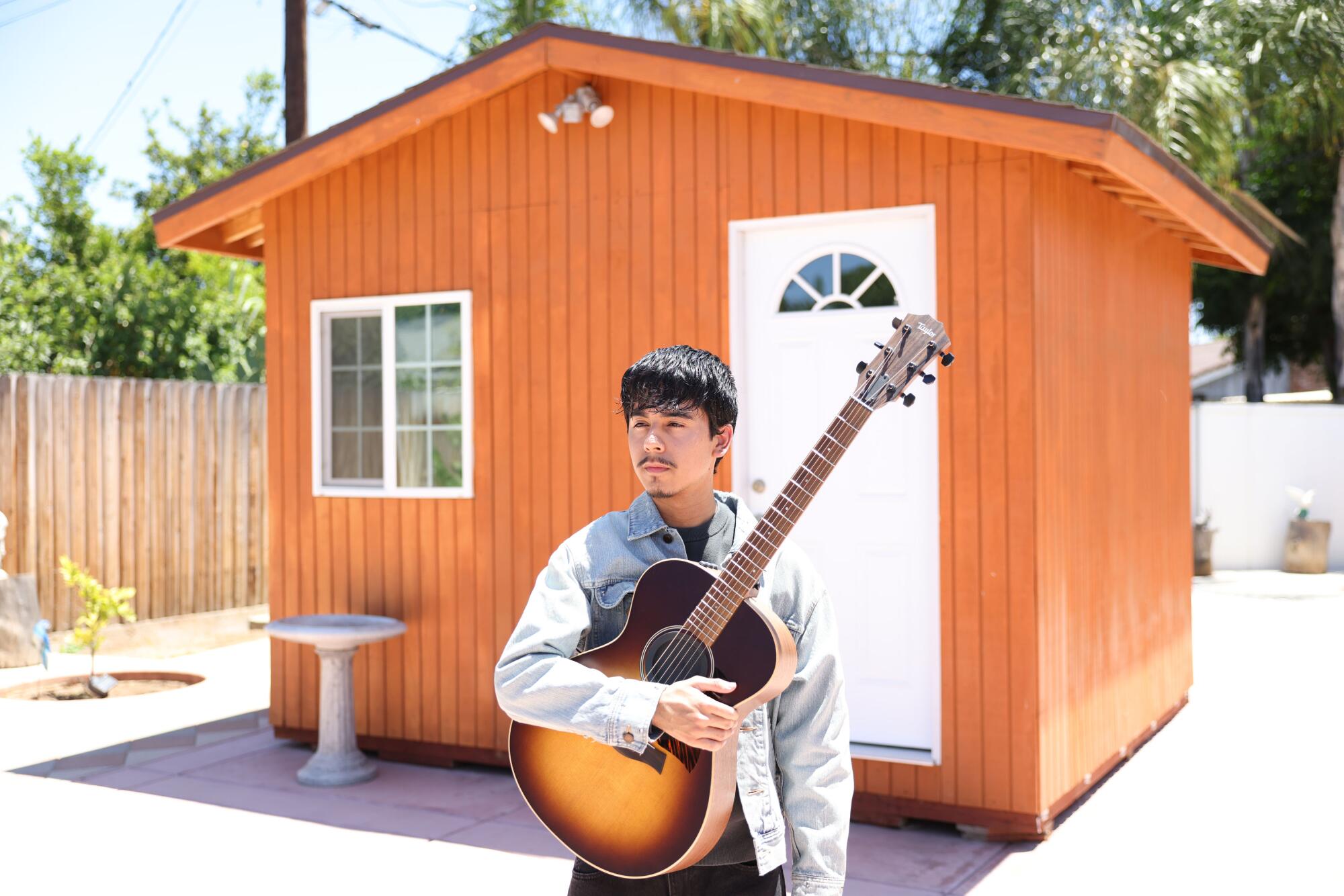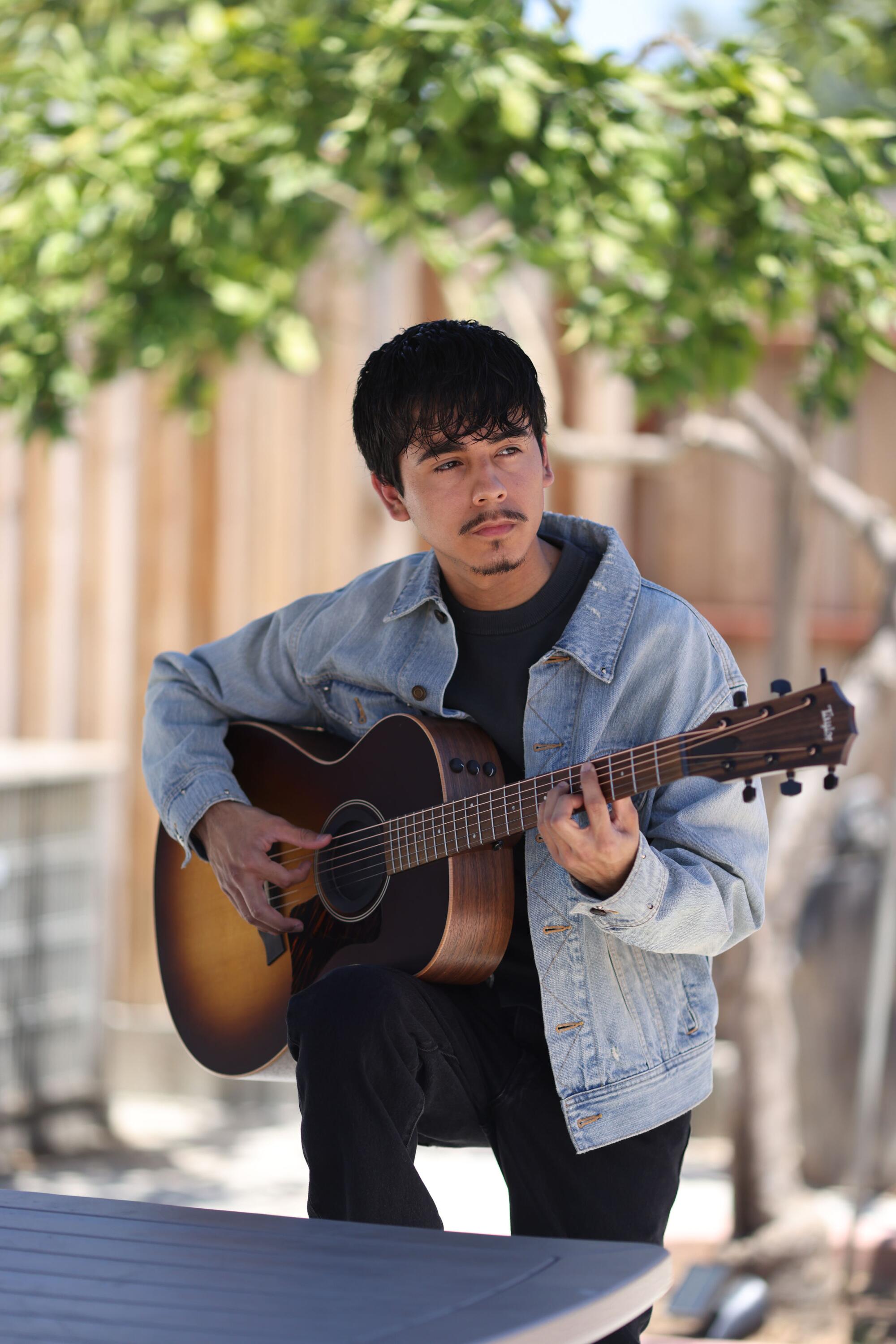
- Share via
Iván Cornejo knew at an early age that he’d find his future in music.
Precocious as a child and an autodidact, the U.S.-born música Mexicana star taught himself to play guitar at age 8 by watching YouTube tutorials. Pretty soon, his hobby would become a calling.
“I saw it for myself. I thought, ‘This is what I want to do for the rest of my life.’ My heart was so big on it,” Cornejo, 20, tells me as we sit in the living room of his parents’ house in Riverside, mere feet from the childhood bedroom where he says he had his epiphany. Save for a denim jacket, the Mexican American singer-songwriter is decked out in black, an outfit befitting the reigning prince of paisa sadness.
Cornejo began to pursue his dream in earnest as a teen, building a sizable following on Instagram and TikTok with covers of Spanish-language lovelorn songs by artists like Eslabon Armado and Junior H, who signed record deals after being discovered on the Internet. In the comments section, followers would compliment the budding musician on his guitar work and the haunting wail of his voice. Privately, he internalized that positive feedback as he fine-tuned his songwriting skills.
At 16, Cornejo dropped out of high school to focus on music full-time.

“It caught them by surprise for sure, but they quickly learned to accept it,” he said of his parents when he informed them of his decision. “They learned that music wasn’t just my hobby, that it wasn’t a pasatiempo. And once they saw my passion for it, how much I really wanted to be an artist, they were left speechless, but they were also very supportive.”
It wouldn’t take long for Cornejo’s gambit to pay off.
In September 2021, he released “Alma Vacia,” an LP containing seven original tracks of heartache and yearning backed by the higher-pitched requinto guitar, on independent label Manzana Records. The debut album was a hit thanks in large part to “Esta Dañada,” a song about falling for a girl who no longer believes in love. Fittingly, the track first blew up on TikTok; a snippet of its chorus (Su sonrisa / su carita / sus manitas / ay, qué delicia) (Her smile / her face / her hands / oh, what delight) became a trend on the app and was used as the soundtrack to more than a million videos. The virality of “Está Dañada” was enough for it to make the Billboard Hot 100 (it peaked at No. 61), becoming only the second regional Mexican single to debut on the chart. Since then, more than 60 songs classified as regional Mexican have cracked the list, a testament to the genre’s rapid exponential growth in the United States.
The following year, mere days before his 18th birthday, Cornejo proved that he was more than a one-hit wonder with the release of “Dañado.” The sophomore LP performed better than its predecessor, topping the Mexican regional albums chart and peaking at No. 28 in the Billboard Hot 200.
Whereas other música Mexicana acts have built massive audiences by singing about their bellicose escapades, Cornejo has made a name for himself by focusing on matters of the heart. It’s not uncharted territory — the history of Mexican music abounds with singer-songwriters like José Alfredo Jiménez and Cuco Sánchez, yearning balladeers whose catalogs are replete with songs about the million ways in which they’ve lost in love. And while Cornejo might not have invented sad Mexican music, he is certainly introducing it to a younger generation of Mexican American listeners, making it relevant to a subset of the Latino population that’s increasingly becoming English-dominant and could just as easily choose to get their fill of teen angst from someone like Olivia Rodrigo. In that sense, Cornejo is helping his fans connect with their heritage.
“I feel like us Mexicans have always been romantic. I think the most romantic songs are in Spanish,” he says after I asked why, as a bilingual and bicultural artist, he chose to record in Spanish over English. His response echoes a sentiment popular among children of immigrants from Latin America, one that argues that the language of our parents feels warmer, more personal and emotive, than English, which can come across as cold and transactional. That said, Cornejo hasn’t completely ruled out the idea of singing in English — “I have recorded myself trying, but I don’t want to rush it,” he said.

That Mexican romanticism is all over “Mirada,” Cornejo’s latest album, released on July 19 on Zaragoza Records and Interscope. The LP is his most ambitious project to date, delivering the familiar brand of heartache his fans have come to expect without rehashing his past work. To record the album, Cornejo enlisted the help of producer Frank Rios and songwriters Arath Herce and Edgar Barrera, the latter of whom has penned hits for the likes of Peso Pluma, Grupo Frontera, Maluma, Shakira and Madonna.
In “Mirada,” Cornejo seamlessly incorporates his indie rock and folk influences— Tom Odell, Jeff Buckley, Cigarettes After Sex, to name a few — with his patented sad sierreño sound. The end result is an album that sounds equally American and Mexican, raising the bar for what a música Mexicana can sound like.
“I really want to have an evolution in my songs throughout my musical history,” he said. “I want to do it in a way where fans won’t notice it until I play one of my old songs. I want to have it be a natural progression.”

This sonic fusion is most apparent in the album’s titular track, which opens with an isolated electric guitar melody reminiscent of early Radiohead before a Spanish guitar enters the mix. In “Quiero Dormir Cansado,” Cornejo takes the 1980s song popularized by Mexican pop singer Emmanuel and turns it into an ethereal cry for help.
Thus far, fans have embraced “Mirada.” Earlier this week, the LP made its debut on the Billboard 200, charting at No. 17.
Next month, Cornejo will be bringing his distinct Mexican American sound on a 26-city arena tour across the U.S. that kicks off in the South, with stops in Nashville, Huntsville, Ala., and Louisville, Ky. — places that have seen their Latino populations explode in recent years.
“It blows my mind! I never thought I’d be able to perform regional Mexican in these cities,” he said.
More to Read
The Latinx experience chronicled
Get the Latinx Files newsletter for stories that capture the multitudes within our communities.
You may occasionally receive promotional content from the Los Angeles Times.







